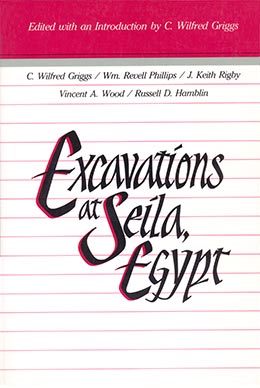Paleopathological Observations and Applications at Seila
Vincent A. Wood
Vincent A. Wood, “Paleopathological Observations and Applications at Seila,” in Excavations at Seila, Egypt, ed. C. Wilfred Griggs (Provo, Utah: Religious Studies Center, Brigham Young University, 1988), 31–44.
Vincent A. Wood was assistant clinical professor, department of restorative dentistry, School of Dentistry, University of California, San Francisco when this was published.
In earlier times, those who excavated in archaeological expeditions paid little attention to the human remains they found and often just cast them aside. Around the turn of the century there were few men pioneering in the field of paleopathology (the study of disease in ancient man). Now, there is quite an interest and thousands of individuals in medical and related disciplines are working in this field. Many methods are being utilized and much has been learned. The information found has been of great help to those who study and attempt to reconstruct ancient cultures.
Ways have been found to reconstitute mummified tissue so it can be studied under a microscope. It is also possible to type the blood of mummies. X-rays of pharaonic mummies have verified hieroglyphic genealogies. We don’t have space here to go into all the procedures available to study and identify ancient remains; suffice it to say that methods are extensive and new techniques are continually being developed.
One of the problems in this field in the past is that most of the studies were done in museums or on material that was collected and brought a great distance from the discovery site. This created many problems in identification and non-correlation with the excavation.
For instance, the Royal Ontario Museum in Toronto, studied a mummy in the early 1970’s that was encased in a beautiful wooden coffin. The inscription on this case indicated the mummy to be Ta-Khat, a woman from the late 18th dynasty in the court of one of the pharaohs. When the case was opened, the mummy proved to be a male.
Another research team received an elaborate coffin. A dentist in the group, when examining the mummy during autopsy, checked the oral cavity and found a number of very contemporary looking fillings in the teeth. There was also a modern looking mustache on the mummy which ultimately proved to be an English diplomat who had been buried some years before in a British cemetery near Aswan. When Egyptian workers sent the coffin they didn’t want to send it empty, so they exhumed this man from a shallow grave and sent him along. These are the kinds of problems that can arise when the study is not done at the site.
There is much to be learned in studying human remains from an archaeological site. Again, at the Royal Ontario Museum in Toronto, a number of leading men in the field of paleopathology performed an autopsy on a male mummy in 1974. He was well identified as a sixteen-year-old weaver from the city of Thebes named Nakht. The autopsy showed a quantity of granite dust in his lungs. As there is no granite in the whole area of Thebes and the closest granite site is 120 miles away in Aswan, the researchers went through some of the legal records found near Nakht’s coffin and were enlightened. Apparently, people were punished for minor infractions of the law by being put to work trimming granite from statuary being prepared for pharaonic monuments. From the autopsy, they were able to show that this young man had spent some months in the granite quarries. Paleopathological investigations like this help give a fuller picture than one would perhaps find in any other way.
Not many paleopathology studies have been done on site where medical personnel are able to analyze specimens as they are removed from the ground. That the BYU Seila Expedition is a multi-disciplinary group that can do such studies makes it somewhat unique.
Fag el-Gamous is a large cemetery and a very productive archaeology site. Excavation was done slowly so we could see any artifact that was exposed. Then we worked with a brush and trowel to further uncover what had been found.
When a specimen was unearthed, measurements were recorded to show distance from the sides of the excavation square, and its depth. A catalog number was assigned and photographs taken to show magnetic orientation, size, date and site burial designation (fig. 1). To complete even the simplest comparative demographics, several basic determinations were made: for example, determination of sex, age, and measurements taken for the purpose of estimating the living stature. Close observation was also made for any pathological anomalies that might exist. A rather careful examination of the oral cavity and associated structures was made. Notes were taken on the level of dental attrition, missing teeth, extent of periodontal disease, carious lesions, and root surface abrasion.

Several long boards, used as burial sticks, were found in one of the burial sites. (Most of the mummies, when they were well wrapped, had reinforcement poles of various types. Sometimes they were palm fronds that had all of the leaves cut off.) After unwrapping the mummy, we examined the boards closely and discovered rusty nails in them. This seemed unusual for materials so old. We discovered three iron nails, caulking-like material which was jammed into a crack of one board, and a dowel hole which had been plugged. Perhaps these sticks had been parts of some kind of boat; prior to being used as burial sticks.
On most mummies that had wrappings preserved, we found a face bundle. Several layers of material were folded over the face and sewn together. Some face bundles had folded clothing in them. The burial clothes that we found were of many types and colors, many of very fine weave and well preserved. Some of the cloth was so strong we could not tear it. Usually there was a fine outer linen with a stronger wrap inside and a thinner cloth layer below that.
One problem we had in the dig was uncovering human material so rapidly that we had a difficult time cataloging and recording the information. In the first area, we found 23 mummies; in the second area, 24; in another, 30; and in the last one we excavated, there were 47 mummies. Some were well wrapped and others came without preserved burial cloth, in skeleton form. Most of the skeletons couldn’t be moved without disarticulating them. We carefully gathered all the pieces, removed them to a protected place and then analyzed them. Some mummies were so well preserved you could see the toe prints.
Now, as we move to a discussion of the dentition, we must mention a rather outstanding specimen that had an excellent set of teeth (fig. 2). It was a female about 23 years of age. She had all her teeth, they were in good alignment, and there were no caries present. She had a normal bite relationship and no periodontal disease. The only problem we could see was a darkness of the enamel layer. In the other mummies we examined, the teeth were not as good.
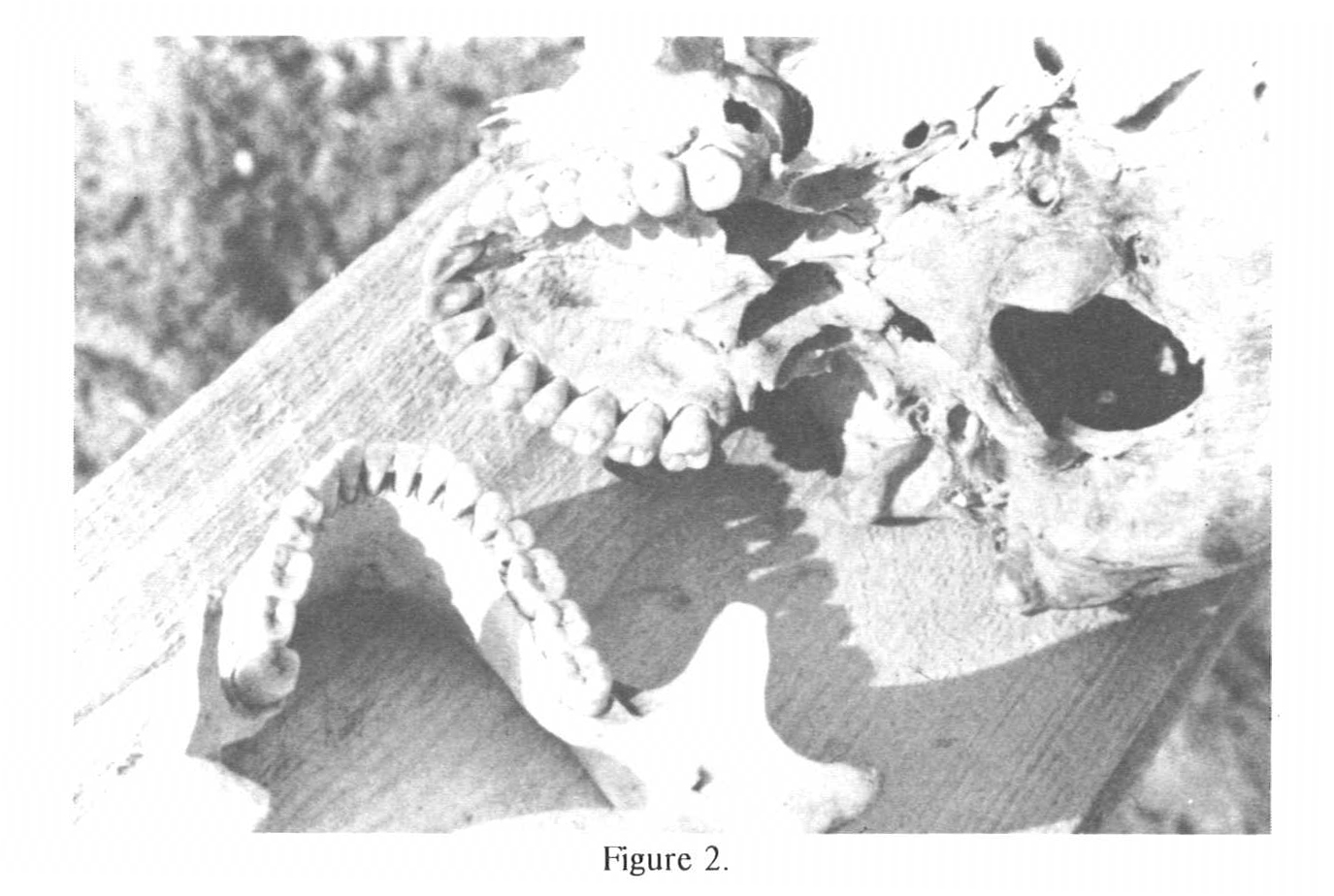
Periodontal disease was a major problem in this population. In many mouths, there were calculus or mineral deposits on the labial surface of anterior teeth. This is rarely seen in our modern society because we have toothbrushes. Many teeth were lost from periodontal disease and a few specimens showed osteoporosis in the tooth socket (fig. 3).
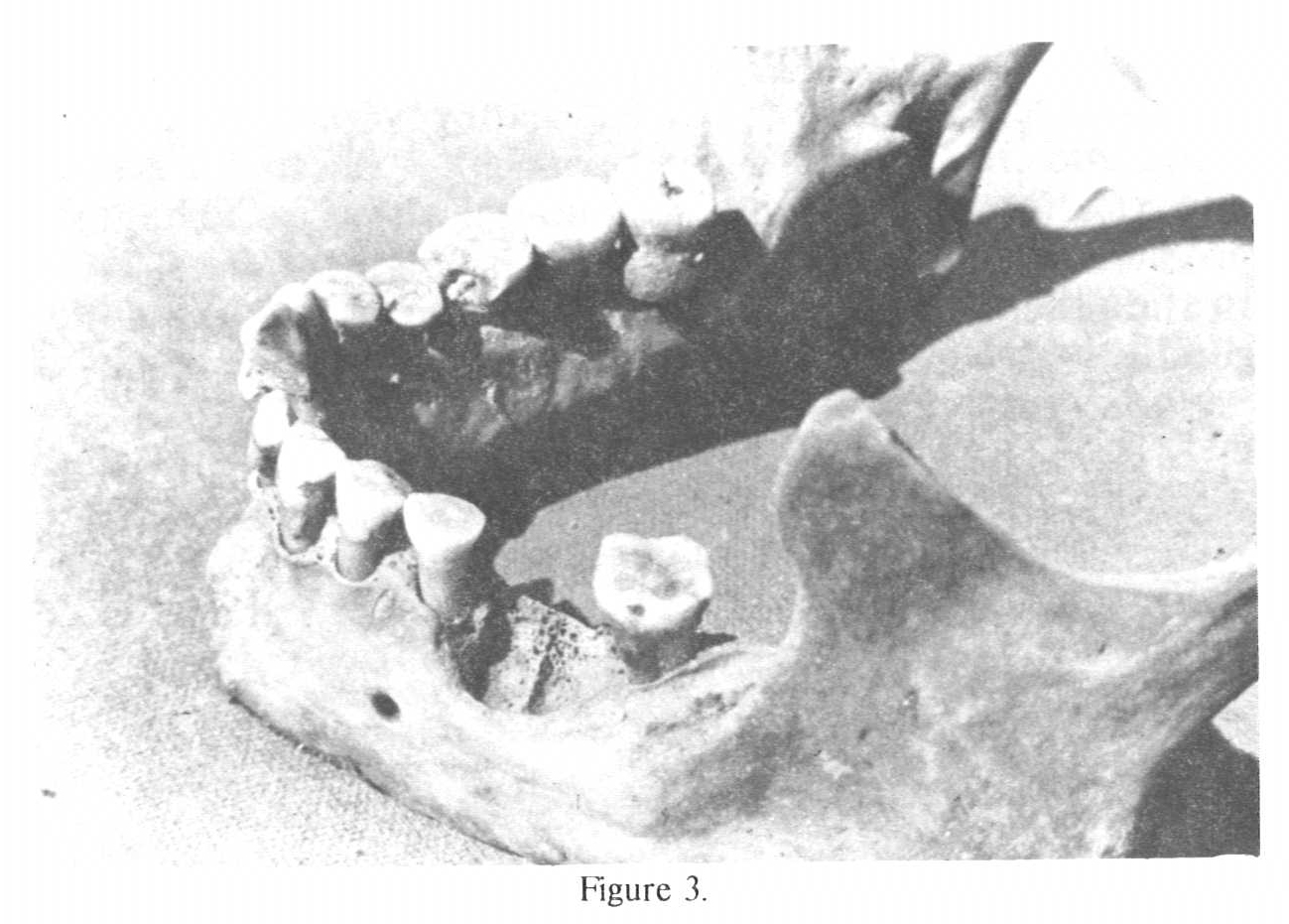
As we discussed and analyzed some of the wear characteristics on the teeth of the mummies, we decided to study, for comparison, some of the local Egyptian workers digging at the site. We tried to take pictures of their teeth, but they wouldn’t open their mouths and we didn’t have any retractors. We were able to take only a few pictures of their smiles, but we could see the extensive periodontal disease that is now prevalent in the local community due to lack of oral hygiene. We will discuss the results of the comparisons later in this paper.
Figure 4 is a closeup of a tooth with a gold filling. This tooth was found by our expedition in 1981. Note the gold filling material still in the cavity on the side of the tooth. A gold filling in an upper first molar is impressive and would be difficult to do even today. Whether the decay is out of it or not, we cannot tell. We would like to study this tooth more closely, but unfortunately it has been misplaced in the Cairo Museum. We didn’t find any evidence of dental work in the teeth in any of the other mummies. We observed several mummies with a sort of opalescence, (i.e., the enamel doesn’t have the normal whiteness). The young lady mentioned in figure 2 had this opalescence. We do not know whether this was a hereditary factor. The mummies with this opalescence nearly all came from the lower part of our excavations where extra moisture might have affected the teeth. We plan to investigate this phenomenon further to try to find a solution.

Anthropologists through the years have written a number of articles concerning tooth attrition in ancient populations. Attrition, wear on the biting surface of the teeth, has been one of the main methods used by researchers to estimate the age of human remains (fig. 5). Categorization of the wear patterns used is fairly complicated. Some investigators contrast the attrition levels between the six- and twelve-year molars, and the wisdom teeth. The eruption dates for these teeth are normally six years apart. Since the purpose of this expedition was not solely to study dental attrition, it was decided that complicated methods of measuring wear were not suitable to the existing situation and a simple four stage comparison was adopted:
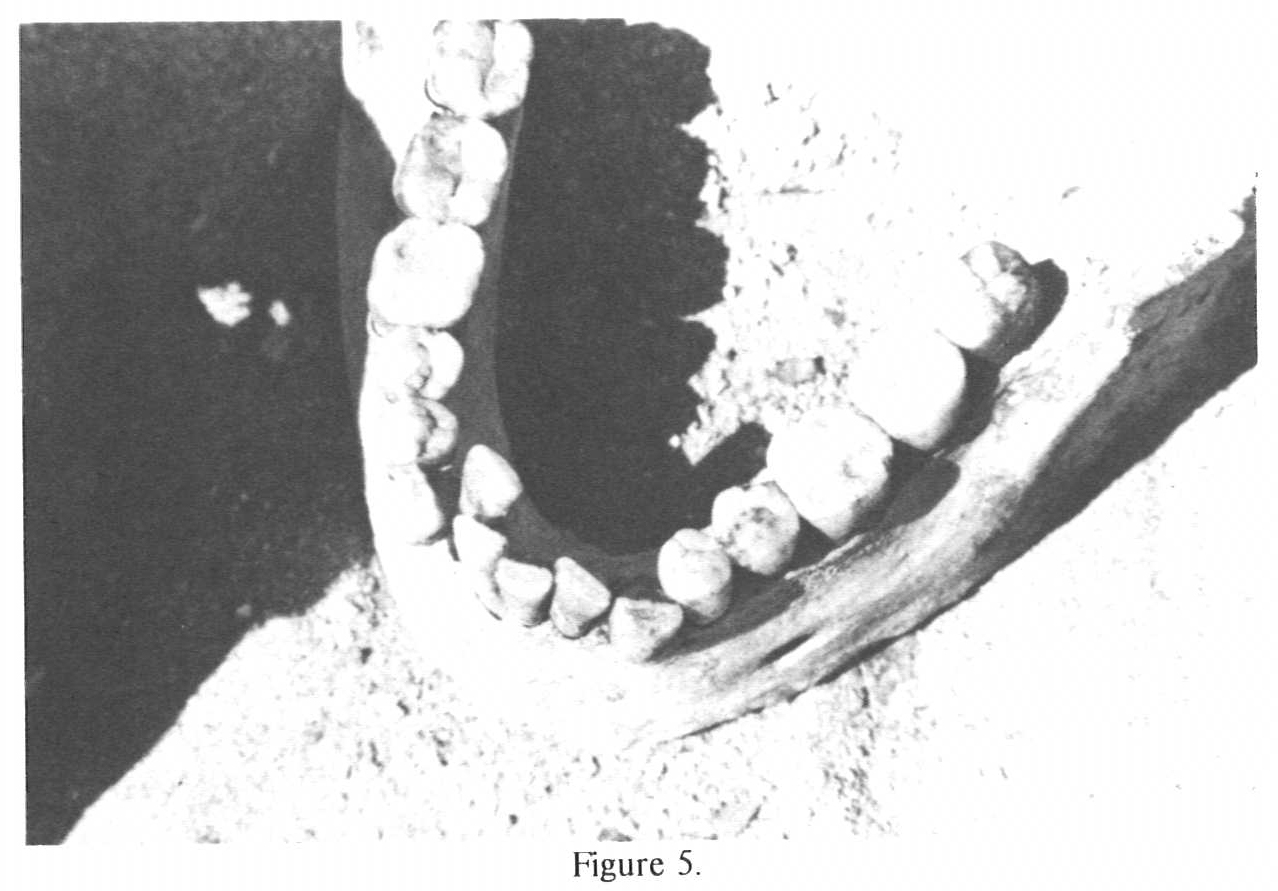
“A” = No appreciable wear.
“B” = Wear mostly in enamel; some dentin showing.
“C” = Completely through enamel; well into dentin.
“D” = Wear through dentin; exposed pulp area.
A general overall-impression of the wear pattern was recorded by the examiner, and each mummy was assigned one of the above stages. We will not include a detailed report of the attrition study findings here, but will only note that a slight majority of the mummies exhibited minor attrition, with 44 of 70 in groupings “A” and “B,” and only 10 fit into classification “D,” excessive wear.
In many studies of attrition patterns, the common assumption is that wear increases in a more or less direct ratio with age. In our own society there are many variations in occlusal wear patterns and rates not attributable solely to time. Some similar inconsistencies were observed in this study. For example, 11 mummies in the 40-plus age group showed little or no appreciable wear.
Stress and tension are apparently some of the main predisposing factors to bruxism and clenching of the teeth. Individuals with such habits usually exhibit higher tooth attrition than others of the same age. It is likely that ancient man also experienced stress, and this might account for some of the discrepancies observed. Other individual variations that must be considered in analyzing dental wear are the following: heredity, diet, habits, occupation, hardness of enamel and associated structures, malocclusion, pathology, trauma, accidents, loss of teeth and use of teeth as tools.
It has been said that the people in the rural areas of Egypt today live much as they did in ancient times. With this thought in mind, we undertook a study of the dentition of 16 local workers employed as diggers at the site. They all lived within 1 or 2 km of the cemetery site and their average age was 32 years. (This matched closely the average age of the mummies in this study.) Lack of dental care was apparent, with generally poor oral hygiene, and observation of modern attrition patterns produced unexpected results:
|
Category |
1984 |
Ancients |
|
A (little or no wear) |
50% |
24% |
|
B (some wear in dentin) |
44% |
44% |
|
C (wear well into dentin) |
6% |
2% |
|
D (wear into pulp) |
0 |
15% |
F. F. Leek, a British peleopathologist, reports that ancient people introduced small quantities of brick dust, chalk or fine sand in the process of milling their grain. Obviously these materials in bread would cause an increase in the rate of attrition. Today, the Egyptian government provides bread milled by modern methods.
Because many conditions may influence attrition of the teeth, we conclude that dental attrition remains a relatively unreliable method of aging human remains.
In a modern dental practice, the dentist sees many patients exhibiting abrasion on the root surfaces of their teeth. This is generally referred to as cervical abrasion. There is not complete agreement as to which etiological factors are responsible for this destruction of the tooth surface. Two main theories have been proposed by researchers in the field to explain inconsistent patterns of abrasion. The most predominant theory identifies energetic toothbrushing as the principle factor. There is an increasing group of adherents, however, for the theory that cervical abrasion is caused by flexing and torsional forces on the tooth as it bends slightly from the stresses of bruxism and heavy chewing. When we had almost completed our excavations and were contemplating the demographic implications, we realized that, in all of our observations, we had not noticed any examples of root surface abrasion. This observation certainly is noteworthy. After returning from Egypt, we noted reports of other excavated collections that also record little to no abrasion on the root surfaces of large numbers of individuals. The implications of this phenomenon which is predominant in modern societies and rare in ancient peoples are surely challenging. It is tempting to present one’s considered explanations to lend support to whichever theory one espouses, but at this time we do not have sufficient data to draw valid conclusions. I cannot resist noting, however, that both theories lose some credibility as we observe mummies exhibiting extensive attrition (even into the pulp chamber) while showing no cervical destruction.
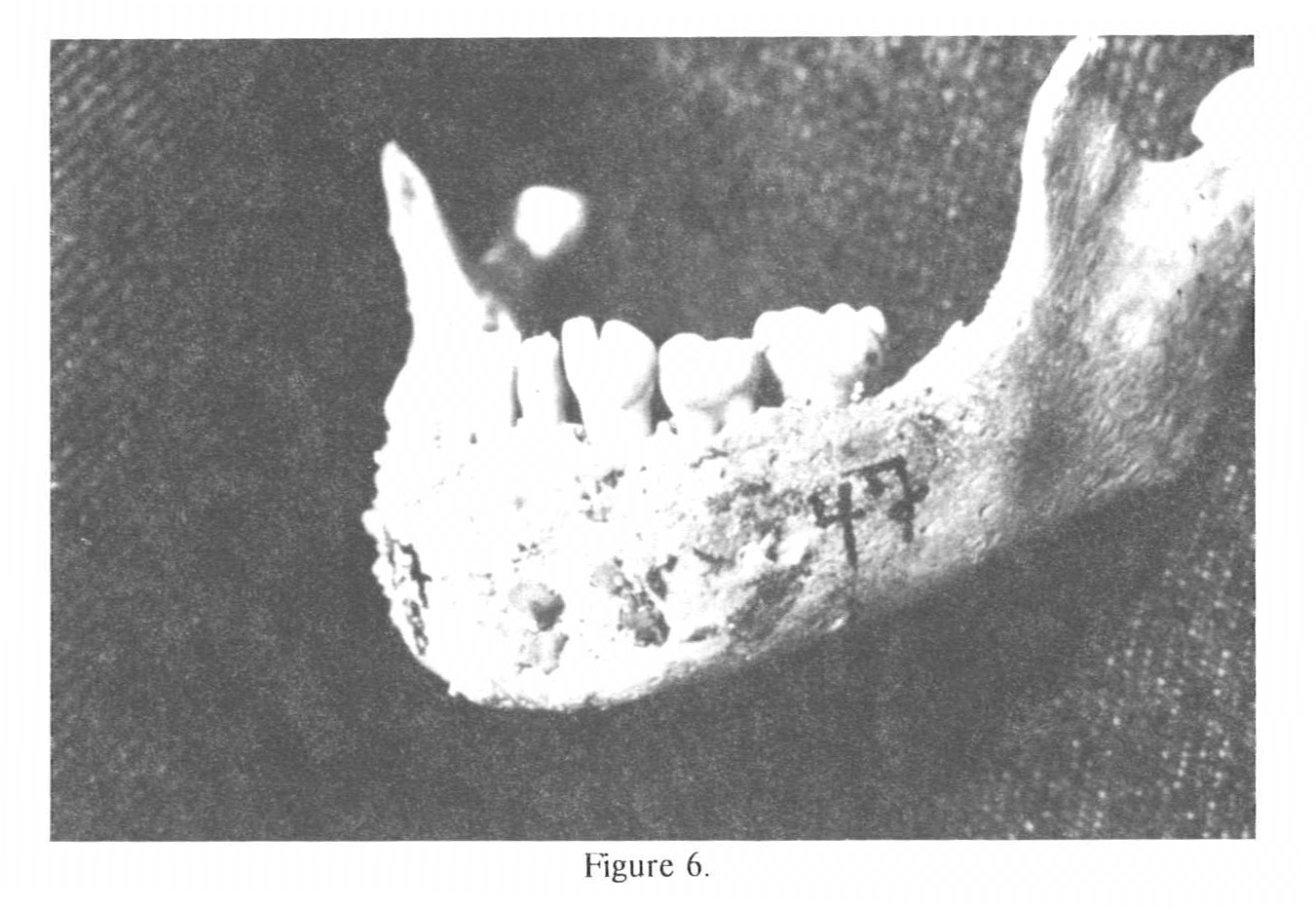
As we studied the mummies, we noted other anomalies. Two teeth of one child had formed together (fig. 6). This is referred to as concrescence. One skull had a suture line across the middle of the frontal bone. This occurs in 1 to 2% of the modern population and it is called metopism, or a metopic suture. We observed several instances of wormian suture lines. These are highly irregular and meandering sutures in the occiput region of the skull. Several skulls we exhumed, showed evidence of traumatic injury. One chap had three clearly delineated slices into the skull which made us think he might have been struck by a sword or axe. Because the edges of these lesions were still sharp, we might conclude that these blows, or others received elsewhere, were fatal. In macabre contrast, another skull exhibited a large wound that had completely healed with bone filling in the defect (fig. 7). The blow was struck in the middle of the frontal bone or forehead and fractured the skull for a distance of 5 to 6 centimeters, even displacing the nasal bones. We can but conjecture on the life he lived or the pain he endured, but we do know that he lived long enough for the bone to heal.
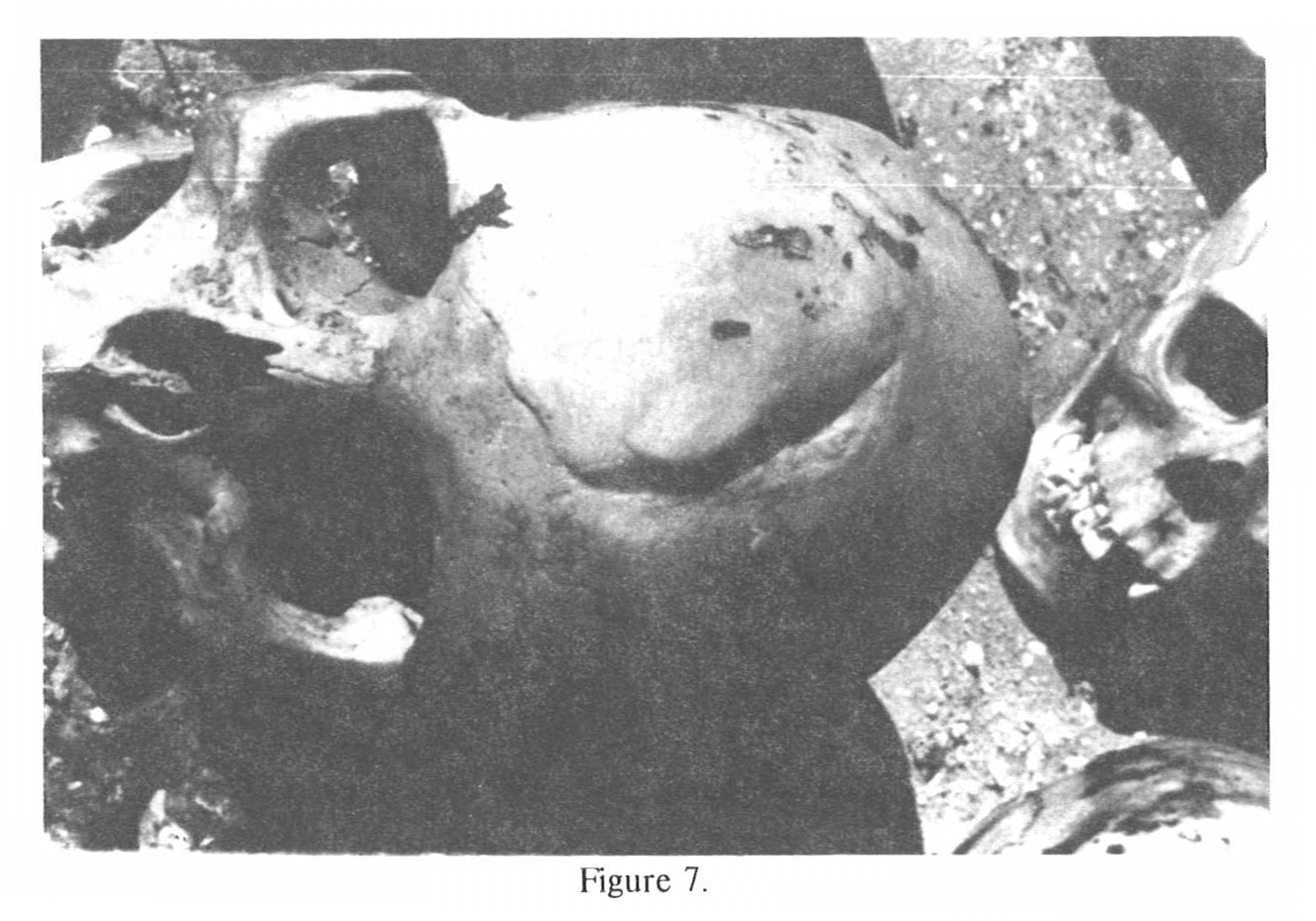
After we finished our examinations, we reburied the skulls so that we will be able to retrieve them next year. We are looking forward to this as there are several interesting things we want to check. The defect shown in figure 8 is one of them. As we reviewed the films we noticed this very unusual lesion on the mandible about 3 cm in diameter. I have shown the pictures of it to several well-known pathologists at the University of California, San Francisco, and none of them has been able to say with certainty what might have caused the defect. It doesn’t seem to be invasive into the bone and the way the edges are a bit rolled and rounded suggests it was starting to heal. The overall appearance suggests pressure as one might observe in a cyst or some other soft tissue lesion. One pathologist suggested that perhaps a glancing blow from a sword that almost missed could have sliced off a thin layer, and then the wound started to heal. Next year we would like to examine this skull closely with X-rays and other tests.
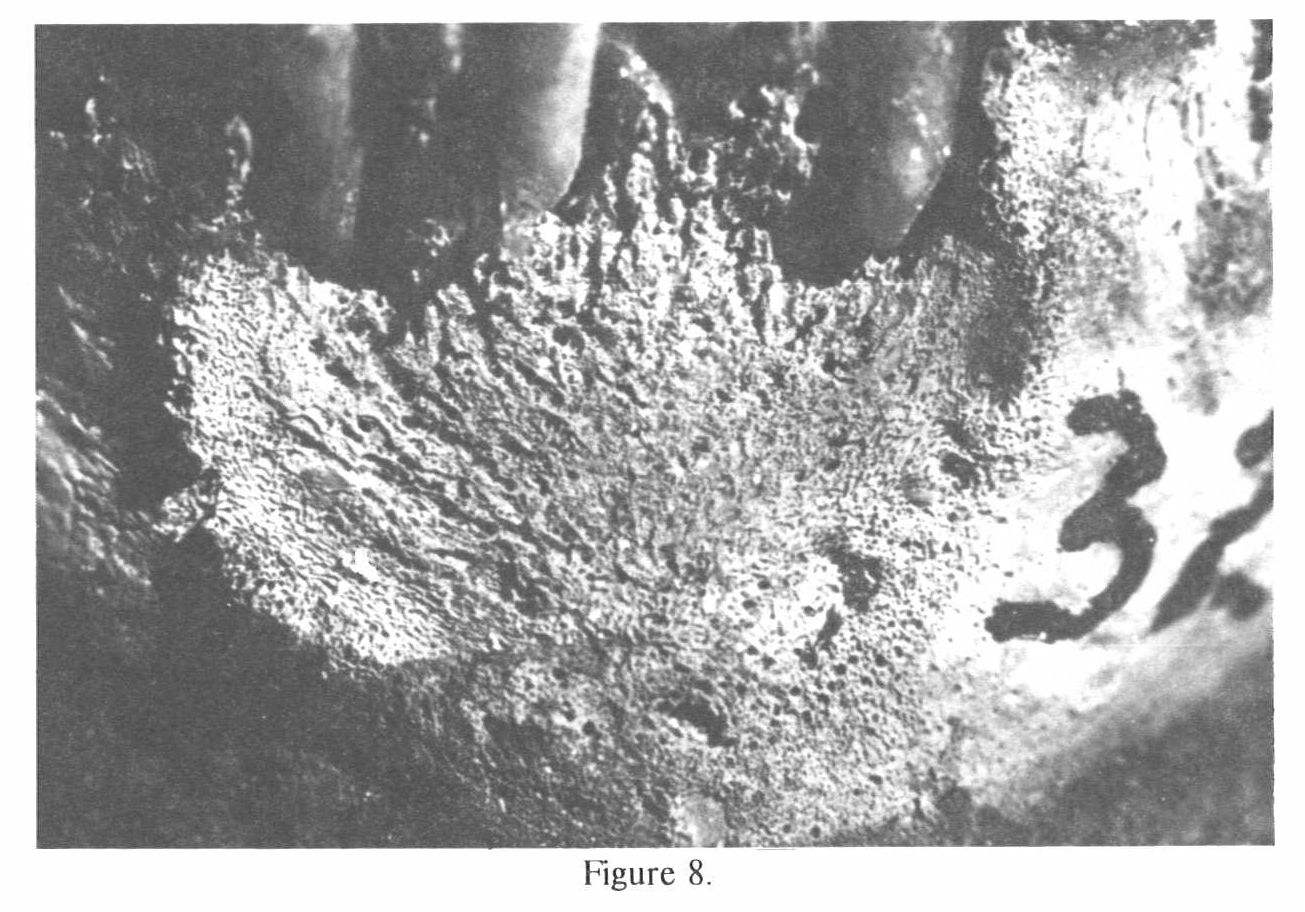
Many exhumed bones had clear, colorless, slightly opaque crystals extruding from the surface of the lamina dura. The crystals were quite varied in size and shape. We observed some that twisted into a regular spiral, others formed stubby traditional crystalline prisms, and there were a few that were as thin as thread, 2–3 inches long (fig. 9).
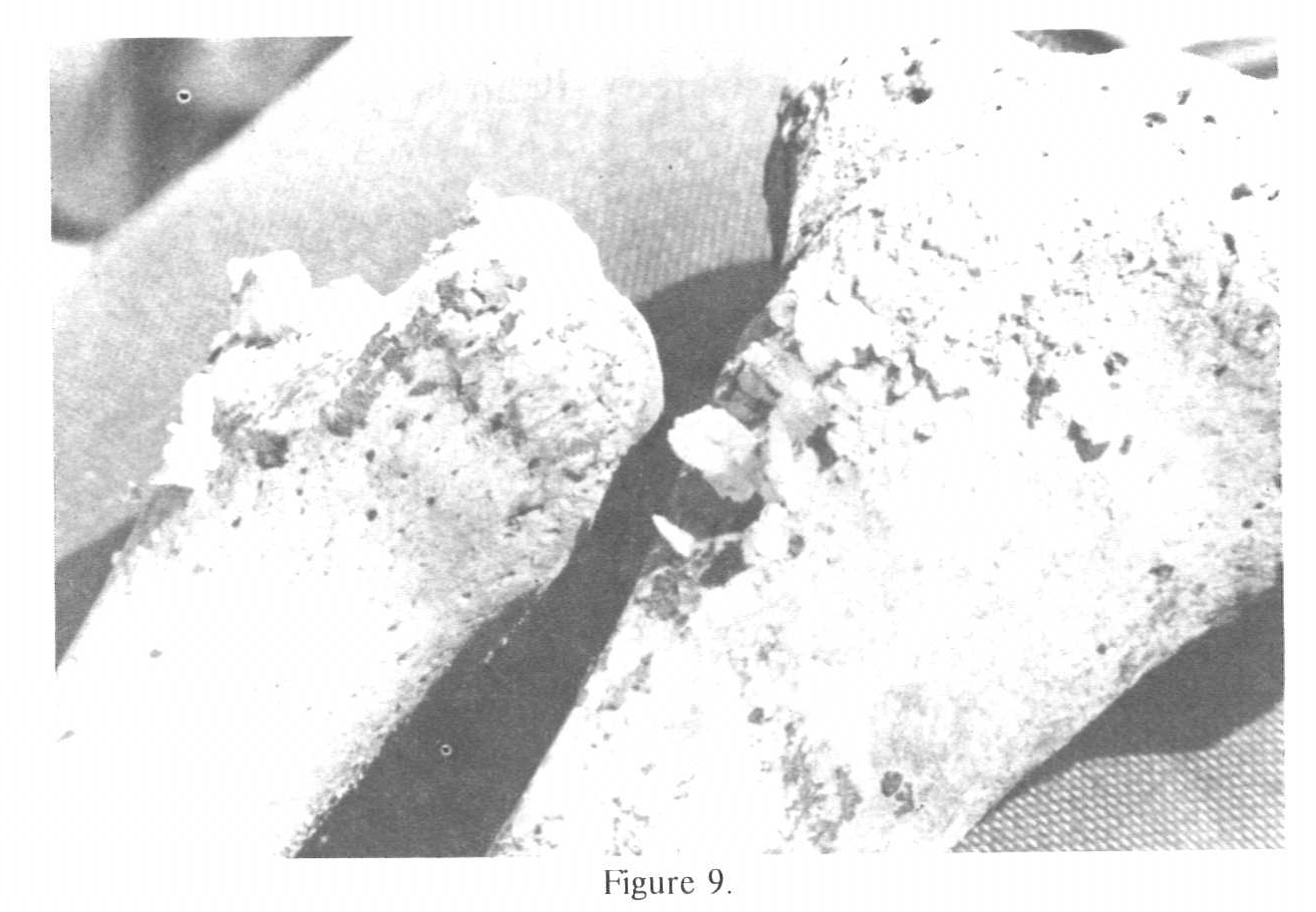
After we had finished analyzing and cataloging the mummies, we reburied them in one of the larger pit tombs. The skulls were carefully placed in a shallow pit and gently covered with desert sand for protection until next year. Now that we have a building to store specimens for further work and extensive study we will not have to resort to reburial.
We hope that in this limited presentation you have been able to see some of the potentialities that are just over the horizon in this field. There are many possibilities for exciting discoveries in the future with numerous questions remaining to be answered. It all is quite fascinating and extremely rewarding.
